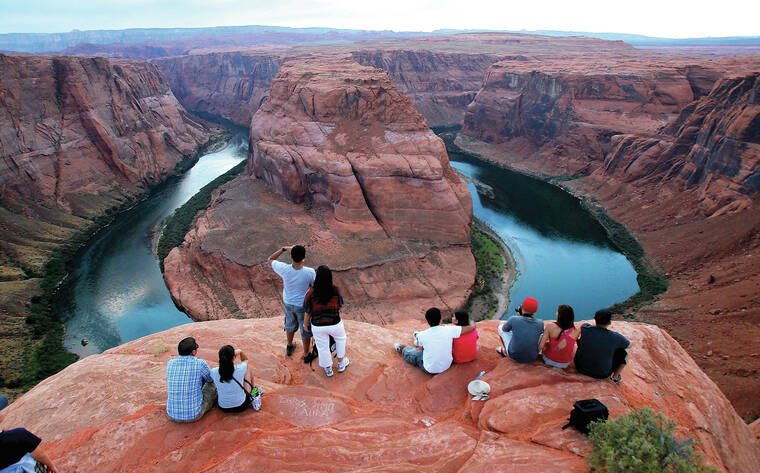Deadline looms for western states to cut Colorado River use
SALT LAKE CITY — Banks along parts of the Colorado River where water once streamed are now just caked mud and rock as climate change makes the Western U.S. hotter and drier.
More than two decades of drought have done little to deter the region from diverting more water than flows through it, depleting key reservoirs to levels that now jeopardize water delivery and hydropower production.
ADVERTISING
Cities and farms in seven U.S. states are bracing for cuts this week as officials stare down a deadline to propose unprecedented reductions to their use of the water, setting up what’s expected to be the most consequential week for Colorado River policy in years.
The U.S. Bureau of Reclamation in June told the states — Arizona, California, Colorado, Nevada, New Mexico, Utah and Wyoming — to determine how to use at least 15% less water next year, or have restrictions imposed on them. The bureau is also expected to publish hydrology projections that will trigger additional cuts already agreed to.
Tensions over the extent of the cuts and how to spread them equitably have flared, with states pointing fingers and stubbornly clinging to their water rights despite the looming crisis.
Representatives from the seven states convened in Denver last week for last minute negotiations behind closed doors. Those discussions have yet to produce concrete proposals, but officials party to them say the most likely targets for cuts are Arizona and California farmers. Agricultural districts in those states are asking to be paid generously to bear that burden.
The proposals under discussion, however, fall short of what the Bureau of Reclamation has demanded and, with negotiations stalling, state officials say they hope for more time to negotiate details.
“Despite the obvious urgency of the situation, the last sixty-two days produced exactly nothing in terms of meaningful collective action to help forestall the looming crisis,” John Entsminger, the General Manager of the Southern Nevada Water Authority wrote in a letter on Monday. He called the agricultural district demands “drought profiteering.”
The Colorado River cascades from the Rocky Mountains into the arid deserts of the Southwest. It’s the primary water supply for 40 million people. About 70% of its water goes toward irrigation, sustaining a $15 billion-a-year agricultural industry that supplies 90% of the United States’ winter vegetables.
Water from the river is divided among Mexico and the seven U.S. states under a series of agreements that date back a century, to a time when more flowed.
But climate change has transformed the river’s hydrology, providing less snowmelt and causing hotter temperatures and more evaporation. As the river yielded less water, the states agreed to cuts tied to the levels of reservoirs that store its water.
Last year, federal officials for the first time declared a water shortage, triggering cuts to Nevada, Arizona and Mexico’s share of the river to help prevent the two largest reservoirs — Lake Powell and Lake Mead — from dropping low enough to threaten hydropower production and stop water from flowing through their dams.
The proposals for supplemental cuts due this week have inflamed disagreement between upper basin states — Colorado, New Mexico, Utah and Wyoming — and lower basin states — Arizona, California and Nevada — over how to spread the pain.
The lower basin states use most of the water and have thus far shouldered most of the cuts.
The upper basin states have historically not used their full allocations but want to maintain water rights to plan for population growth.


